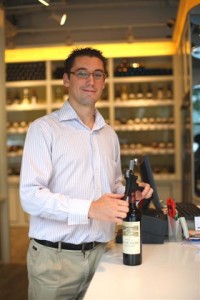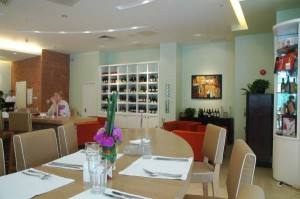By Jim Boyce
Wine importer and retailer Top Cellar started business about two years ago in Beijing. I talked to GM Julien Bonnard about the company’s strategy, customer mix, and forays into China’s second-tier cities as well as the biggest challenges he faces.
–
What strategy has Top Cellar followed over the past two years?
We wanted to create a portfolio different from supermarkets, mass retailers like Metro, and gourmet shops like Jenny Lou’s. We did it by sourcing from local suppliers and finding wines that are exclusive, such as those sold only in hotels and restaurants. The result is that only about five percent of Top Cellar wines, brands such as Santa Rita and Casillero del Diablo, can be found at these other retailers.
In terms of venues, we opened our first two shops in January 2007 – one in Central Park and one on Financial Street – and took over the Bentos and Berries outlet in the Kerry Center Hotel the following March.
We then opened the lounge and restaurant Amigo across from the Central Park shop and that gave us a platform for events. Each month, we have an in-store feature and we use tastings at Amigo to promote this. We have featured wines from Burgundy, Chile, the Loire Valley, South Australia, and elsewhere. These events have allowed us to create a good database of wine customers.
–
When did Top Cellar start importing wine?
About six months after starting the business. We brought in a container of wine from Bordeaux in 2007 and it sold easily because we could offer good prices and something new to the market. We have since imported two brands from Chile and one from New Zealand, and will soon have one from Australia. We also plan to bring in wine from Spain and Italy.
–
Top Cellar is also operating in smaller cities in China.
Yes, at the beginning of this year, we started to develop second-tier city channels. We now work with 15 distributors around China, including in Chongqing, Chengdu, Dalian, and Qingdao. All are owned and run by Chinese who understand those particular markets. We work hard to find quality operations and to cooperate with them on promoting wine culture.
Every new wine company in this market goes to the same channels – private customers, on-trade outlets such as hotels and restaurants, or retailers such as supermarkets or Carrefour, where the profit margins are very low. We are looking for different avenues for selling our wine.
–
What is the customer mix at Top Cellar?
In the beginning, we attracted mostly foreigners, but now our clientele is about 40 percent Chinese. Our Chinese customers tend to want French wine and are especially attracted to Bordeaux. As they try other wines, they also tend to like Chilean, which offer good value and are easy to drink.
–
Where is Top Cellar’s retail effort heading next?
We opened a shop in the diplomatic compound by the new U.S. Embassy a few weeks ago – in Grand Summit. Business is already picking up because we have a good selection of wine and a well-designed space. But the biggest goal at the moment is to find a good location in Sanlitun.
We also have one store in Shanghai, which operates as a platform for the brand. The market there is very competitive and locations are very expensive.
–
What are the biggest challenges for you?
For me, the biggest challenge is to find good store locations with reasonable rents. Retail competition is quite strong: Even though the biggest distributors don’t have stores, they do offer product delivery, and that means they pretty much operate as wine stores via the Internet or teams that develop private customer bases.
It is also hard to find wines with good margins. If you work with big distributors, the margin is small and there is the chance they might take a brand with only a few sales channels and put it in the supermarkets. The wines we import ourselves are only 10 percent of the portfolio, so it is a major challenge to fill that other 90 percent with products that are both unique to the market and have good margins.
Another challenge is training wine store staff to deal with the needs of each customer. All of our employees have basic WSET training and some have level two or three. This at least teaches them the basics. They also pick up knowledge along the way – sometimes I hear employees talking about trying wines, identifying grapes, and so on. That helps customers in the end.
–
How did you end up in China?
I came because of a project with a chamber of commerce in La Rochelle in France. The French government sponsors grants for projects that might lead to exports and it liked our proposal to look at wine sales networks in China – the companies involved, the channels used, the kinds of customers, and so on.
I had an internship with Alain Leroux, the wine maker for Taillan in Beijing, so I could learn more about the market. During my research, I met many people and decided to learn more about off trade, so I joined the wine distributor Summergate as an intern and then later as part of a team to develop supermarket activities.
I worked at Summergate for two years and then someone approached me from a Hong Kong-based company called Universal Technology Trading to see if I was interested in the Top Cellar project. That is how I ended up where I am today.
–
Are you positive about wine in China?
If we talk about the big cities, such as Beijing and Shanghai, we already have too many companies and the market isn’t growing as fast as it did during the past three or four years. The challenge is finding a place for your wines. For the established companies, it won’t be a big problem, but for smaller companies that don’t know anything about wine and think this is simply a good way to make money, it will be challenging and difficult.
But one thing of which I am quite confident: When I travel to smaller cities, I see more and more people who are interested in wine. It’s just beginning out there.
–
Note: If you like this blog, please vote for it in the China Blog awards. Just go here and click the “plus†sign.
Sign up for the Grape Wall newsletter here. Follow Grape Wall on LinkedIn, Instagram, Facebook and Twitter. And see my sibling sites World Marselan Day, World Baijiu Day and Beijing Boyce. Grape Wall has no advertisers, so if you find the content useful, please help cover the costs via PayPal, WeChat or Alipay. Contact Grape Wall via grapewallofchina (at) gmail.com.


Leave a Reply
You must be logged in to post a comment.